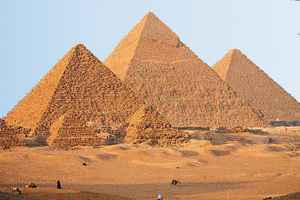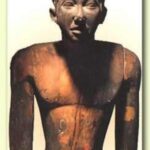Pyramids of Egypt continue to fascinate and inspire wonder and awe in the minds of not only tourists but also of students, historians, archaeologists, scientists, mathematicians and architects alike for the sheer stupendous magnificence of it and the magnitude of mathematical calculations, precision craftsmanship and engineering with human labor and effort that have been expended in completing these mind boggling majestic structures. Over 90 royal pyramids were built by the ancient Egyptians from 2630 B.C. to 1530 B.C.
The first pyramid is said to have been built by Imhotep, the architect of King Djoser during the period 2630 B.C. to 2611 B.C. by placing six bench shaped mounds called mastabas each smaller than the one beneath it in a stack so as to ultimately form a pyramid rising in steps. This pyramid can be seen at Sakkara near Memphis on the West bank of the River Nile. A normal pyramid (later versions) contains many chambers, rooms and passages including the burial chamber of the king. By 2560 B.C., the smooth sided pyramid had evolved during the reign of King Snefru, founder of the fourth dynasty (2680 B.C. to 2560 B.C.)
The largest pyramid ever built is the Great Pyramid of Giza, which was built by King Khufu during the period 2551 B.C. to 2528 B.C., which is one of the Seven Wonders of the World. The base of the pyramid measures 13 acres and its sides are 755 feet long and rise at an angle of slightly over 51 degrees. Although it originally stood at 481 ft. high, today it stands only 450 ft. high with part of its top dismantled. It is estimated that 2.3 million stones went to its construction with one of its stones weighing an average of over two tons with the largest stones at the base estimated to weigh over fifteen tons each.
Pyramids are seldom found in singles, but form part of a group of buildings including temples, chapels, other tombs etc. How and for what purposes those buildings were used is not clear but it is believed that the king’s body was brought in a boat up the River Nile for burial in the pyramid after being mummified in the Valley Temple by the river bank.
In the absence of factual records, a comprehensive evaluation of how the pyramids were built is sheer conjecture and speculation based on available evidence of drawings and carvings on stones supported by mathematical calculations and scientific research. It is believed that the workmen would have used an abrasive powder such as sand with the drills and saws and that they would have had a sound knowledge of astronomy to orient pyramids to the cardinal points. As for transporting the stones from quarries to the sites of the pyramids it is believed that they were moved on sledges over ground made slippery first with some liquids. These blocks were then lifted up the ramps to their intended positions in the pyramid after which the ramps were later dismantled after each section of work was completed. Most of the stones used for the Giza pyramids were quarried on the Giza plateau itself and limestone casing brought from Tura across the Nile while some of the rooms were cased with granite from Aswan. However, with regard to logistics of labor usage, there are wide variations from more modern estimates of about 36,000 workmen to as much as 100,000 workmen working 10-hour shifts over 20 years. It is the Greek historian Heroditus who revealed in the fifth century B.C. that he had been told by his Egyptian guides that 100,000 men were employed at the rate of only three months an year for twenty years. Further, contrary to popular belief that most of the workmen employed were slaves and foreigners, reliable evidence has been found to establish that they were Egyptian peasantry who worked with a lot of dedication and with a sense of pride for the cause of their King.
It is observed that the fourth to the sixth dynasties marked the apex period for pyramid building, while only smaller pyramids were built during the next thousand years. Though some of them have been discovered there are yet more believed to be buried under the desert sand. The pyramid building later gradually diminished as it became evident that the pyramids failed to provide protection for their kings but was only benefiting vandals who broke into them for robbery of valuables buried. Due to this reason it became the practice in later years to bury the bodies of kings in hidden tombs cut into rocky cliffs.
Although pyramids failed to give protection to the mummified bodies of their kings, nevertheless they have succeeded in preserving to this day the names of the kings who built them.




